Corsair RM750i Power Supply Review
Corsair is revamping its RM line, adding the letter "i" to highlight a more advanced digital interface — today we check out the RM750i.
Why you can trust Tom's Hardware
Efficiency, Temperature And Noise
Efficiency
Our efficiency testing procedure is detailed here.
Using the results from the previous page, we plotted a chart showing the RM750i's efficiency at low loads, and loads from 10 to 110 percent of the PSU's maximum-rated capacity.
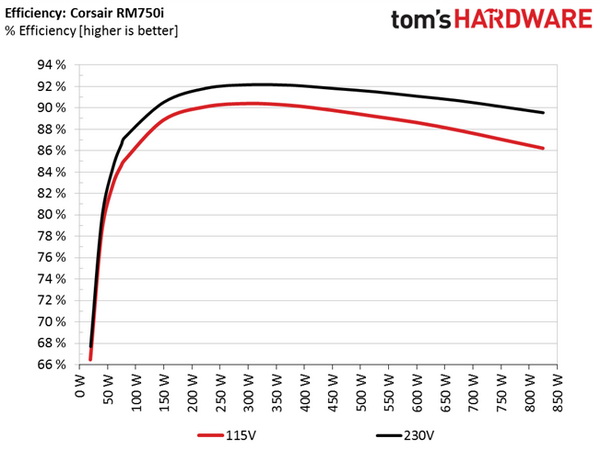
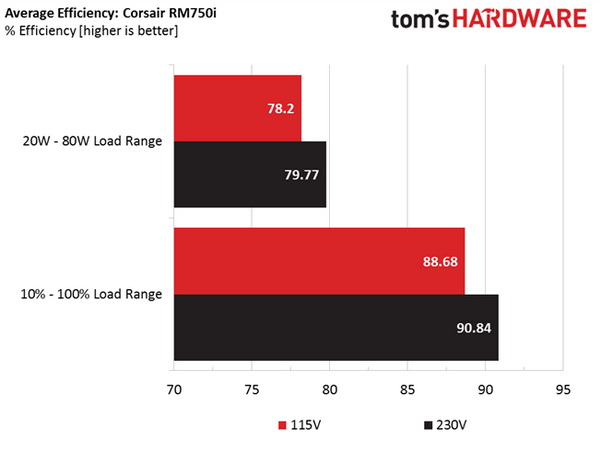

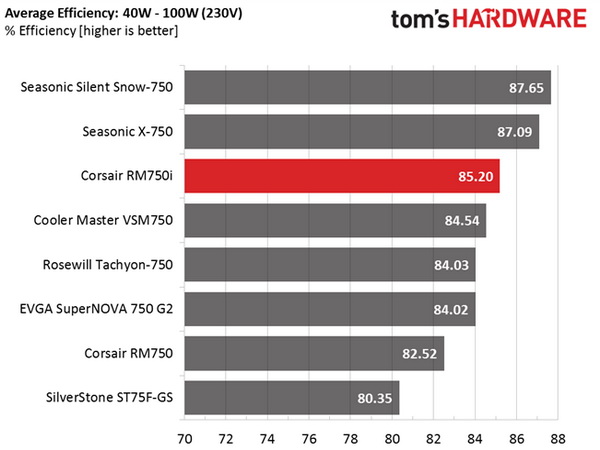
Efficiency is pretty high for the standards of this category (750 W - 80 Plus Gold) at both light and normal loads. Compared with the older RM750 model, this unit offers a significant improvement at light loads, while at higher loads (20 – 100 percent) the efficiency difference is small.
Efficiency At Low Loads
In the following tests, we measured the efficiency of the RM750i at loads significantly lower than 10 percent of the device's maximum capacity (the lowest load the 80 PLUS standard measures). The loads we dialed were 20, 40, 60 and 80W. This is important for representing when a PC is idle, with power-saving features turned on.
| Test # | 12V | 5V | 3.3V | 5VSB | Power(DC/AC) | Efficiency | Fan Speed | Fan Noise | PF/AC Volts |
|---|---|---|---|---|---|---|---|---|---|
| 1 | 1.201A | 0.498A | 0.479A | 0.200A | 19.64W | 66.49% | 0 RPM | 0 dB(A) | 0.844 |
| 12.119V | 5.000V | 3.332V | 4.991V | 29.54W | 115.1V | ||||
| 2 | 2.432A | 0.998A | 0.990A | 0.400A | 39.74W | 78.40% | 0 RPM | 0 dB(A) | 0.935 |
| 12.114V | 4.999V | 3.332V | 4.988V | 50.69W | 115.1V | ||||
| 3 | 3.668A | 1.495A | 1.500A | 0.600A | 59.88W | 82.86% | 0 RPM | 0 dB(A) | 0.960 |
| 12.110V | 4.999V | 3.331V | 4.984V | 72.27W | 115.1V | ||||
| 4 | 4.887A | 2.002A | 1.980A | 0.800A | 79.74W | 85.07% | 0 RPM | 0 dB(A) | 0.970 |
| 12.105V | 4.998V | 3.330V | 4.980V | 93.74W | 115.1V |
At very low loads the PSU performed pretty well, with its efficiency surpassing the 80 percent mark during the last two tests, with 60 W and 80 W loads. In addition, the PSU operated in passive mode throughout the testing, although the ambient temperature was close to 40 °C (104 °F).
Corsair Link Screenshots
You will find several screenshots of the Corsair Link software below, which we took during our load test sessions.
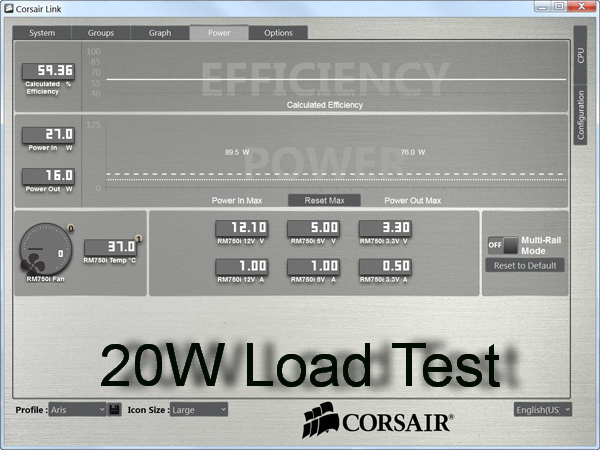

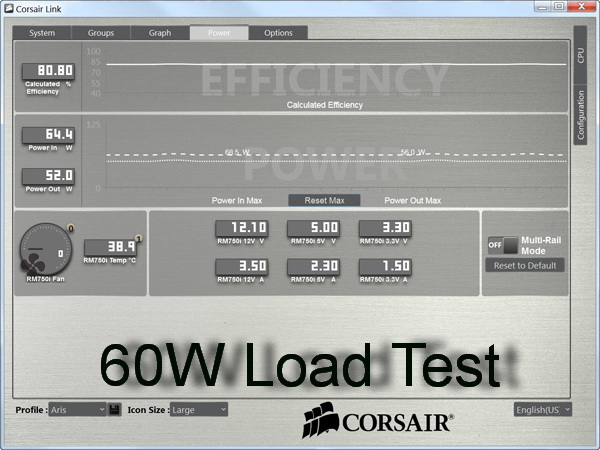
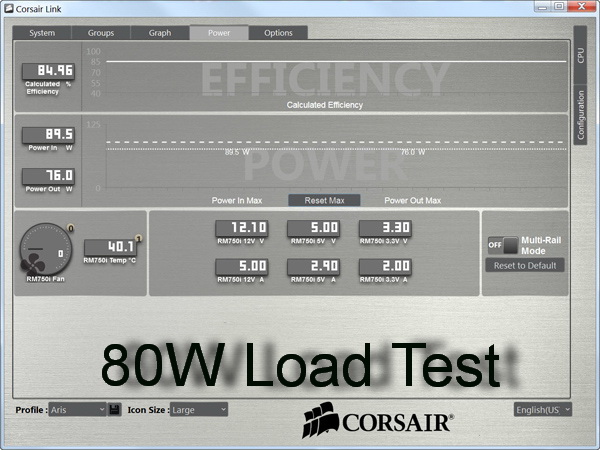
5VSB Efficiency
The ATX specification states that 5VSB standby supply efficiency should be as high as possible, recommending 50 percent or higher efficiency with 100mA of load, 60 percent or higher with 250mA of load, and 70 percent or higher with 1A or more of load.
Get Tom's Hardware's best news and in-depth reviews, straight to your inbox.
We will take four measurements: one each at 100, 250 and 1000mA, and one with the full load the 5VSB rail can handle.
| Test # | 5VSB | Power (DC/AC) | Efficiency | PF/AC Volts |
|---|---|---|---|---|
| 1 | 0.101A | 0.51W | 76.12% | 0.066 |
| 5.037V | 0.67W | 115.1V | ||
| 2 | 0.251A | 1.26W | 79.75% | 0.142 |
| 5.033V | 1.58W | 115.1V | ||
| 3 | 1.002A | 5.02W | 81.63% | 0.319 |
| 5.013V | 6.15W | 115.1V | ||
| 4 | 3.002A | 14.89W | 79.80% | 0.422 |
| 4.960V | 18.66W | 115.1V |
The 5VSB rail is highly efficient even at very light loads. The low consumption in idle mode surely played a key role in this.
Power Consumption In Idle And Standby
| Mode | 12 V | 5 V | 3.3 V | 5VSB | Power (AC) | PF/AC Volts |
|---|---|---|---|---|---|---|
| Idle | 12.120V | 5.007V | 3.337V | 5.005V | 8.65W | 0.474 |
| 115.1V | ||||||
| Standby | 0.05W | 0.005 | ||||
| 115.1V |


In the table above, you'll find the power consumption and voltage values of all rails (except -12V) when the PSU is idle (powered on, but without any load on its rails), and the power consumption when the PSU is in standby mode (without any load, at 5VSB).
"Vampire power" is very low, one of the lowest we have ever measured. The previous RM750 model also has very low power consumption at idle. (Vampire power, also known as standby power, refers to the power devices’ waste just by being plugged in and not in use.)
Fan RPM, Delta Temperature And Output Noise
Our mixed noise testing is described in detail here.
The first chart below illustrates the cooling fan's speed (RPMs), and the delta between input and output temperature. The results were obtained at 40 °C (104 °F) to 47 °C (116.6 °F) ambient temperature.
The next chart shows the cooling fan's speed (RPMs) and output noise. We measured acoustics from 1 meter away, inside a small, custom-made anechoic chamber with internals completely covered in sound-proofing material (be quiet! Noise Absorber kit). Background noise inside the anechoic chamber was below 18 dB(A) during testing, and the results were obtained with the PSU operating at 40 °C to 47 °C ambient temperature.
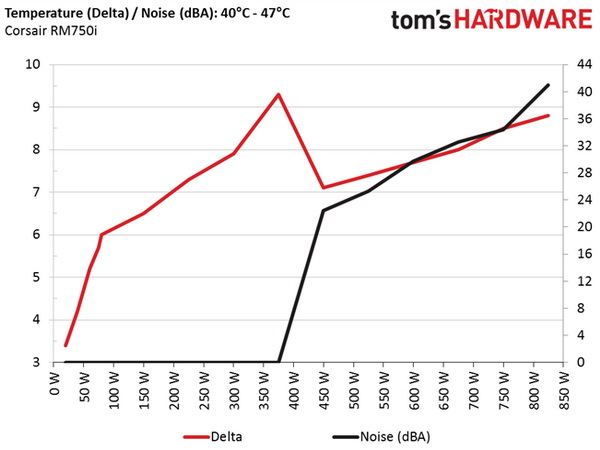
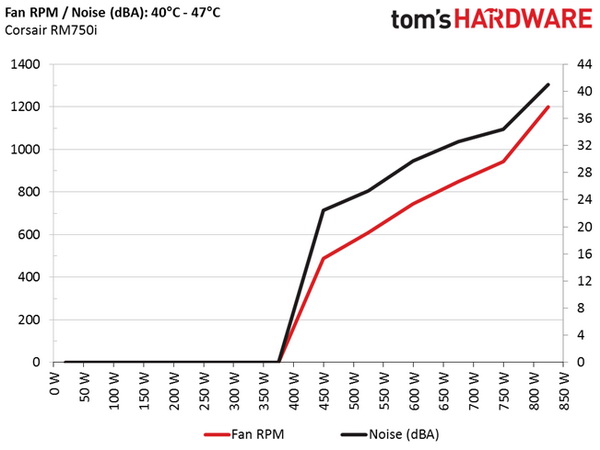
The following charts illustrate the fan's output noise and speed over the entire operating range of the PSU. The same conditions of the above chart apply to our measurements, though the ambient temperature was between 28 °C (82.4 °F) and 30 °C (86 °F).


We noticed something strange during our extended cross-load tests. Although with high ambient temperatures the passive mode lasted for a long time, with normal operating temperatures it lasted for only a couple of minutes. We don't have an explanation for this; however, we should mention that we encountered the exact behavior in an RM1000i unit, which we evaluated recently. In any case, even with the passive mode being inactive, the fan spins at very low speeds most of the time so it is almost inaudible. Up to around a 600 W load the PSU is dead silent, and this means that it will be the ideal choice if you want to build a super-quiet system.
Current page: Efficiency, Temperature And Noise
Prev Page Load Regulation, Hold-Up Time And Inrush Current Next Page Cross-Load Tests And Infrared Images
Aris Mpitziopoulos is a contributing editor at Tom's Hardware, covering PSUs.
-
Luay ArisReply
Thanks for the thorough review.
The RM750i does beat the G2 750 at $10 more, which is a good trade for a mpore quite operation, and is $20 cheaper than the Snow Silent 750, but how does it compare to the $10 more expensive P2 750? -
Aris_Mp I am sorry but I haven't reviewed the P2 750 model yet. However since it is Platinum it should be compared with the HX750i.Reply -
Luay No I'm comparing it based on price.Reply
Since the gold rated RM750i and the platinum P2 750 are $10 apart, excluding the rebate, and as Jonny (The Jonny??) said, a few %s of efficiency isn't as important to me as something as tangible as emitting noise. -
Dan414 This seems like the droids/PSU I've been looking for. That or maybe the 850i. Also, I like the white lettering - that way it will match my case no matter what lighting I have inside.Reply -
synphul I'm confused, there's no other product that compares to the corsair rm750i except the evga g2 750 and the seasonic snow silent 750 which is a higher category and price. Yet isn't that the ss-750km3 sitting at $10 cheaper?Reply
Cwt may be improving but it's not ss quality. Hard to face the two off when they're so close in price or the seasonic is cheaper. I fail to see how it's a better option than the competition. A better option than their own lineup maybe, but that's not saying a ton.
I suppose it's true it comes with corsair link, though with psu's already this quiet not sure the need is there to control the fan beyond active variable control built in and silent mode at low draw. I've never needed to monitor my psu temp or control the fan speed even on a plain old active fan design. Comes off as a bit gimmicky to try and create added value. Don't get me wrong, this would be nice on an otherwise loud psu with no fan control and no silent operation mode at all but in the face of being quiet and having variable/silent fan operation it's a little redundant.
Idk, like I said it's nice to see they're trying to improve quality in some areas but they don't even come in under the competition. As of right now they're more expensive than the competition. Personally I'll stick with seasonic. -
trifler If any PSU companies read this, I want to see molex discontinued, at least on the non-modular power supplies. At least offer some power supplies that don't have molex.Reply -
fil1p It's good to see that all the caps a Japanese on this one. I like Corsair PSUs, but the last gen RM series had some lower quality caps in there, which quite frankly shouldn't have been in an enthusiast PSU at that price point in the first place.Reply -
jonnyguru Reply16336613 said:Cwt may be improving but it's not ss quality.
How do you know? ;-)
16336613 said:I suppose it's true it comes with corsair link, though with psu's already this quiet not sure the need is there to control the fan beyond active variable control built in and silent mode at low draw. I've never needed to monitor my psu temp or control the fan speed even on a plain old active fan design.
You can also monitor voltages and load and calculate efficiency. So it does a lot more than what you're stating.